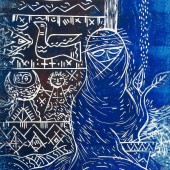
This 1953 painting by celebrated Iraqi painter and sculptor Jewad Selim exhibits the artist’s abstracted, two-dimensional approach to form and rhythmic use of the crescent and square. As one of the founders of the Baghdad Group for Modern Art (1951), along with his student and friend Shakir Hassan Al Said, Selim and his colleagues sought to forge a modern art through a process of cultural renewal that was oriented towards the rediscovered local tradition of the 13th century style of manuscript illumination exemplified by Yahya ibn Mahmud al-Wasiti in the Maqamat of al-Hariri, the most popular Arabic text chosen for illustration in medieval Iraq. Critical to their vision of a contemporary art was experimentation with various traditions and techniques, including the art of Pablo Picasso, who is explicitly referenced in the Group’s 1951 manifesto. Visual continuity between the past and present was thus part of this pioneering vision of istilham al-turath, “[seeking] inspiration from tradition.” Woman Selling Material, painted just two years after the founding of the artists’ collective, combines a playful linear construction, surface flatness due to a lack of shading, and interest in geometry that marks Selim’s openness to different influences and a dynamic interplay of various visual traditions.
During his short career, Selim left an imprint as a pioneer of Iraq’s modern art movement. In 1938, he studied in Paris on a government scholarship, relocating to Rome two years later after the German invasion of France in the Second World War. Selim studied sculpture at London’s Slade School of Fine Art between 1946 and 1949. Returning to Baghdad soon afterwards, Selim founded the Institute of Fine Arts’ sculpture department. Selim obtained a grant to construct the Monument of Freedom memorial for Iraq’s 1958 revolution (which still stands in Baghdad), but died of a heart attack before its completion.
رسم هذه اللوحة الرسام والنحات العراقي الشهير جواد سليم عام 1953، وهي تجسد النهج التجريدي ثنائي الأبعاد الذي تبناه الفنان في تشكيل الهلال والمربع واستخدامهما بشكل متناغم. وبصفته أحد مؤسسي “جماعة بغداد للفن الحديث” (1951) مع تلميذه وصديقه شاكر حسن آل سعيد، سعى سليم وزملاؤه إلى تكوين فن حديث من خلال عملية تجديد ثقافي كانت موجهة نحو إعادة اكتشاف التقليد المحلي لأسلوب القرن الثالث عشر في زخرفة المخطوطات والممثلة عموماً من قبل يحيى بن محمود الواسطي في كتابه “مقامات الحريري”، وهي أكثر النصوص العربية التي تم الاستشهاد بها لتوضيح هذا الفن في العراق خلال العصور الوسطى. ومن المقومات الأساسية لرؤيتهم في تطوير فن معاصر كان تجريب مختلف التقاليد والأساليب بما في ذلك فن بابلو بيكاسو الذي أشير إليه بوضوح في بيان الجماعة عام 1951. وكانت الاستمرارية البصرية بين الماضي والحاضر جزءاً من هذه الرؤية الرائدة في “استلهام التراث”. وتجمع لوحة “امرأة تبيع بضاعة”، التي رسمها سليم بعد عامين فقط على تأسيس الجماعة، بين البنية الخطية المرحة والسطح المستوي بفعل انعدام التظليل، والاهتمام بالأشكال الهندسية الذي يميز انفتاح سليم على تأثيراتٍ مختلفةٍ والتفاعل الديناميكي لتقاليد بصرية متنوعة.
وخلال مسيرته الفنية القصيرة، ترك سليم بصمة رائدة في حركة الفن الحديث بالعراق. وبدأت هذه المسيرة عام 1938، حيث درس في باريس بمنحة حكومية، وانتقل بعد عامين إلى روما عقب الغزو الألماني لفرنسا خلال الحرب العالمية الثانية. ودرس سليم فن النحت في “مدرسة سليد للفنون الجميلة” في لندن خلال الفترة بين عامي 1946 و1949. وبعد عودته إلى بغداد بفترة وجيزة، أسس قسم النحت في معهد الفنون الجميلة. وحصل جواد سليم على منحة لبناء نصب الحرية تخليداً لثورة تموز 1958 في العراق (ولا يزال النصب موجوداً في بغداد)، لكنه توفي جراء نوبة قلبية قبل إكماله.







